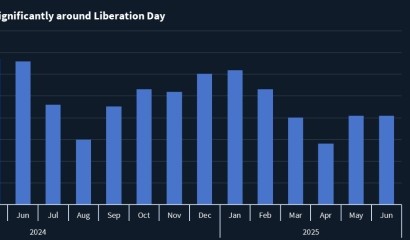EMEA IPO market might be stalled for some time without central bank help
The IPO market in Europe, the Middle East and Africa (EMEA) is firmly shut, with global volatility spiking in reaction to harder-than-expected tariffs introduced by US president Donald Trump.
There are still hopes that new listings will resume in the second half, but history suggests that it might more than a couple of quarters for markets to reopen without global central bank intervention.
The CBOE’s much-feared Vix Index, the global benchmark for US equity volatility, has spiked to levels last seen during the worst days of the Covid-19 pandemic. There is a general acceptance among equity practitioners that a Vix above 20 makes IPOs hard to execute. At levels near 50, as was the case as of 9 April, listings are nearly impossible, given a typical marketing period of four weeks.
There is a substantial pipeline of deals in EMEA that are now either on hold or cancelled entirely.
On-hold transactions include German pharmaceutical business Stada, which had been expected before the Easter break. It was expected to be joined by Spanish gaming company Cirsa, a deal which was also put on ice. There are now reports that the company’s owner Blackstone is exploring a sale to another private equity firm.
There is a substantial pipeline of deals possible in 2H25 as well, including large listings of Dutch telecommunications provider Odido, Portugal’s Novo Banco and Swiss security solutions business Verisure.
If the market follows a similar trend to previous volatility spikes, the second half might be too soon for a re-opening of the IPO window in EMEA, especially if global trade tensions continue.
After the Russian invasion of Ukraine in 2022, and the subsequent inflationary spike that followed, EMEA’s IPO market faced several quarters of declining volumes, driven by lower European issuance, with the mega listing of Porsche in Frankfurt an exception. However, activity in the Middle East made up for the lack of activity in Europe.
Volatility spikes in 2012, at the time of Europe’s sovereign debt crisis, also led to lower IPO volumes for several quarters.
One possibility for a faster turnaround would be if global central banks stepped in to provide bond market liquidity through quantitative easing, or even through dramatically cutting interest rates.
Even when the world seemed to be falling apart during the depths of the pandemic, with several businesses prevented from operating under global lock-down rules, a substantial package of monetary support from global central banks added rocket fuel to equity markets and global IPO issuance soared.
EMEA was carried along for the ride with huge deal volumes in the second half of 2020 and through 2021, although several of these transactions have traded well below offer price since.
If the European Central Bank (ECB) and Bank of England move to ease monetary conditions, possibly in conjunction with the US Federal Reserve, it would likely provide the support required to lift equities, and the EMEA IPO market off the mat. This though might be a pipe dream, at least in terms of the US, with Fed chair Jerome Powell’s latest comments indicating that tariffs could increase US inflation.
Despite this hawkish noise, rate traders are more bullish on the Fed increasing rate cuts in 2025.
There has been little noise from the ECB’s Christine Lagarde or the BoE’s Andrew Bailey since tariffs were introduced, but in the UK rates traders are now betting on more Bank of England rate cuts in 2025 than had been expected as little as a month ago, according to reports.
However, if central banks don’t ride in to save the day, EMEA’s IPO pipe might be shifted to 2026 for a simple reason. In uncertain times, the grass will always be greener in the next window.











